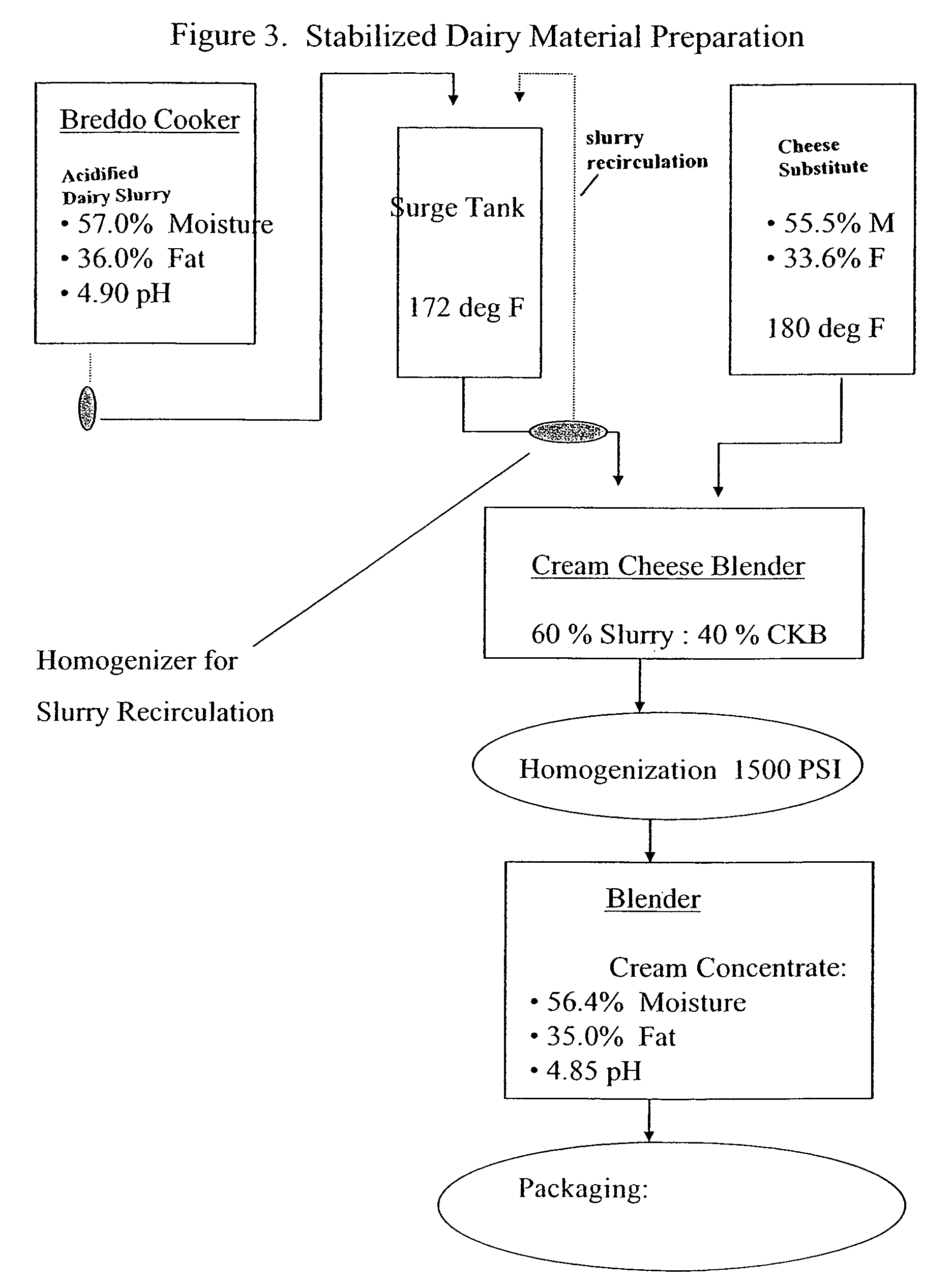Stabilized non-sour dairy base materials and methods for preparation
a non-sour dairy and base material technology, applied in the field of stabilized non-sour dairy base materials and methods for preparation, can solve the problems of limited shelf life, unused waste products, diminishing the desirable sensory attributes, etc., and achieve the effect of prolonging the shelf life of the refrigeran
- Summary
- Abstract
- Description
- Claims
- Application Information
AI Technical Summary
Benefits of technology
Problems solved by technology
Method used
Image
Examples
example 1
Dairy Base Materials with Sodium Acid Sulfate
This example illustrates the preparation and evaluation of dairy base materials of differing formulations and process conditions. Dairy base material samples, designated Samples 1 and 2, were formulated as 60:40 weight ratio blends of an acidified dairy slurry and a cheese substitute. The acidified dairy slurries were formulated with dairy cream, vegetable or dairy fat source, dairy protein source, non-sour acidulant, and optionally gum. The selected sample variables applied are described in Table 1 below.
For dairy base material Samples 1 and 2, two respective batches of acidified dairy slurries were formulated with a fixed level of sweet cream (38% fat, 43.5 TS), non-fat dry milk (NFDM), and one of several different fats (i.e., concentrated milkfat (CMF) or palm oil) to achieve a final fat content of 36 percent. In preparing Sample 1, a first homogenization treatment (2-stage, 3500 / 500 psi) was applied in-line to the acidified dairy slur...
example 2
Evaluations of Dairy Base Materials Made with Sodium Acid Sulfate
After approximately 14 days refrigerated storage (at approx. 37° F.), textural observations of the dairy base material Samples 1 and 2 made according to Example 1 were made, and measurements were taken of pH and texture (firmness). Viscosity for each sample in Alfredo sauce application as well as the viscosity of a natural heavy cream sample in the same application were also measured. Firmness was measured using 2×2×2 inch samples with a TA-XT2 Texture Analyzer with a Ta-4 probe (Texture Technologies Corp., Scarsdale, N.Y.). The results are reported in Table 2 below. Samples were cooled to about 37° F. before testing. Alfredo sauce viscosity was measured using a Haake viscometer model RT-30 with a RT-10 measuring cup and a Rotor Z20 probe with a 4.20-mm gap at 15.5° C.
TABLE 2Dairy Base Material Sample Observations and PropertiesTextureViscositySampleObservationpH(Firmness), g(cp)1Creamy texture, no water4.97586168syner...
example 3
Evaluations of Dairy Base Materials Made with Sodium Acid Sulfate in Sauces
Alfredo sauces were prepared individually with each of dairy base material Samples 1 and 2 made in accordance with Example 1 to evaluate their suitability as replacements for heavy cream in sauce preparations. Sauces 1 and 2, which were prepared with the control dairy material and Samples 1 and 2, respectively, had the formulations indicated in Table 3 below. A control sauce C used natural heavy cream as the dairy material. Sauces were prepared by hydrating flour with required amount of cold water, and then combining all ingredients in a saucepan using a double boiler, over medium heat, stirring constantly until smooth and hot (approx. 180-185° F.).
TABLE 3Dairy Base Material Samples evaluated in Alfredo SauceSauce CSauce 1Sauce 2creamcream subst.Control12Ingredient%%%Full Moisture Parmesan Cheese19.3619.2819.28Heavy Cream74.120.000.00Dairy Base Material0.0030.8428.09Water0.0043.2145.96Butter3.113.113.11Flour2...
PUM
 Login to View More
Login to View More Abstract
Description
Claims
Application Information
 Login to View More
Login to View More - R&D
- Intellectual Property
- Life Sciences
- Materials
- Tech Scout
- Unparalleled Data Quality
- Higher Quality Content
- 60% Fewer Hallucinations
Browse by: Latest US Patents, China's latest patents, Technical Efficacy Thesaurus, Application Domain, Technology Topic, Popular Technical Reports.
© 2025 PatSnap. All rights reserved.Legal|Privacy policy|Modern Slavery Act Transparency Statement|Sitemap|About US| Contact US: help@patsnap.com



